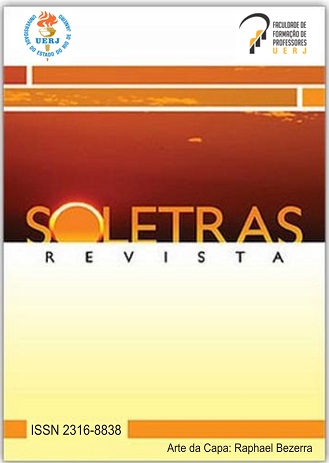The semantics in 19th century didactic materials in confrontation with 21st century textbooks
DOI:
https://doi.org/10.12957/soletras.2025.89634Keywords:
Linguistic historiography, Textbook, Portuguese language semanticsAbstract
This article aims to discuss the study of Portuguese Language semantics in the corpus "Noções de Grammatica Portugueza", by Silva Junior and Andrade (1887), from a historiographical perspective. Among the specific objectives is to compare the teaching of Portuguese language semantics in the 1887 instructional manual with the work "Se liga na língua: literatura, produção de texto e linguagem", by Ormundo and Siniscalchi (2016). This research adopts a qualitative and documentary approach, methodologically substantiated in Linguistic Historiography, privileging the three principles Köerner (1996). The organizational framework follows the guidelines presented by Swiggers (2010), Altman (2012), Batista (2013, 2019), Bastos (2020), Nogueira (2021) between others. The theoretical foundation in semantics revolves around Ilari (1992), Marques (1996), Lyons (1997), Valente (1997), Cançado (2008), Bechara (2009), Henriques (2011), and Abrahão (2018). As a result, the sampling identified that both works provide a semantic study for the linguistic appropriation required for high school students. In the 19th-century work, the semantic phenomena of synonymy, antonymy, paronymy, homonymy, and ambiguity are emphasized, while the 21st-century instructional manual for high school, in addition to these, it was noted the includes teachings of polysemy, hypernymy and hyponymy. Thus, the study of meaning is necessary to promote the development of textual production, reading, and interpretation.
Downloads
Published
Issue
Section
License
The approval of the article implies the immediate and free transfer of the publication rights in this journal. The author (s) authorize the Postgraduate Program in Literature and Linguistics (PPLIN) to reproduce it and publish it in Revista SOLETRAS, understanding the terms "reproduction" and "publication" in accordance with Definition of article 5 of Law 9610/98. The author (s) will continue to own the copyright for subsequent publications. The article can be accessed by the world wide web (http://www.e-publicacoes.uerj.br/index.php/soletras), being allowed, free of charge, the consultation and the reproduction of copy of the article for own use. Cases of plagiarism or any illegalities in the submitted texts are the sole responsibility of their authors.



